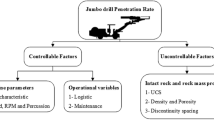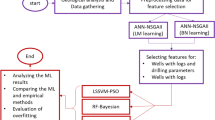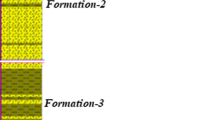Abstract
The predictions of porosity and permeability from well logging data are important in oil and gas field development. Currently, many scholars use machine learning algorithms to predict reservoir properties. However, few scholars have researched the prediction of reservoir porosity and permeability while drilling. This approach requires not only a high prediction accuracy but also short model processing and calculation times as new logging data are incorporated while drilling. In this paper, four machine learning algorithms were evaluated: the one-versus-rest support vector machine (OVR SVM), one-versus-one support vector machine (OVO SVM), random forest (RF) and gradient boosting decision tree (GBDT) algorithms. First, samples of wireline logging data from the Yan969 wellblock of the Yan’an gas field were chosen for model training. To improve the accuracy and reduce the input parameter dimensions and model training time as much as possible, data correlation analysis was performed. Second, we used the grid search method to approximate ranges of reasonable parameter values and then used k-fold cross-validation to optimize the final parameters and avoid overfitting. Third, we used the four classification models to predict porosity and permeability while drilling with data from logging while drilling (LWD) logs. Finally, we indicate the best porosity and permeability prediction models to use while drilling. To ensure that the prediction accuracy is as high as possible and that the model training time is as short as possible, the OVO SVM algorithm was suggested for porosity and permeability prediction. Therefore, appropriate machine learning algorithms can be used to predict porosity and permeability while drilling.














Similar content being viewed by others
References
Sun, J.; Li, Qi.; Chen, M., et al.: Optimization of models for a rapid identification of lithology while drilling—A win-win strategy based on machine learning. J. Petrol. Sci. Eng. 176, 321–341 (2019)
Sun, J.; Li, Q.; Chen, M.; et al.: Optimization of models for rapid identification of oil and water layers during drilling - a win-win strategy based on machine learning. Paper presented at the Abu Dhabi International Petroleum Exhibition & Conference, Abu Dhabi, UAE (2018). https://doi.org/10.2118/192833-MS
J Sun; M Chen; Qi Li; et al. 2021 A new method for predicting formation lithology while drilling at horizontal well bit. Journal of Petroleum Science and Engineering, 196: 107955, ISSN: 0920–4105.
Gang, S.; Ma, L.; Yongfa, X., et al.: Reservoir characteristics of oil sands and logging evaluation methods: a case study from Ganchaigou area Qaidam Basin. Lithol. Rservoirs 27(6), 119–124 (2015)
Salehi, S.M.; Honarvar, B.: Automatic identification of formation lithology from well log data: a machine learning approach. J. Petrol. Sci. Res 3(2), 73–82 (2014)
Qiang, B.; Ting, Z.; Xiaodong, Z., et al.: Application of logging lithofacies identification technology in block A of the Right Bank of the Amu- Darya River. Nat. Gas. Ind. 33(11), 51–55 (2013)
Zhang, D.Q.; Zou, N.N.; Jiang, Y., et al.: Logging identification method of volcanic rock lithology: a case study from volcanic rock in Junggar Basin. Lithologic Rservoirs 27(1), 108–114 (2015)
Yihua, Z.; Rong, Li.: Application of principal component analysis and least square support vector machine to lithology identification. Well Logg. T Echno LOGY 33(05), 425–429 (2009)
Rong, L.; Yihua, Z.: Dentification method of Oil/Gas/Water layer based on least square support vector machine. Nat. Gas Explor. Develop. 32(03), 15–1872 (2009)
Yanjie, S.; Jianfeng, Z.; Weilin, Y., et al.: A new identification method for complex lithology with support vector machine. J. Daq. Petrol. Inst. 31(5), 18–20 (2007)
Liu H., Wen S., Li W., Xu C., Hu C. (2009) Study on Identification of Oil/Gas and Water Zones in Geological Logging Base on Support-Vector Machine. In: Fuzzy Information and Engineering Volume 2. Advances in Intelligent and Soft Computing, Vol 62. Springer, Berlin, Heidelberg.
Li, X.; Li, H.: A new method of identification of complex lithologies and reservoirs: task-driven data mining. J. Petrol. Sci. Eng. 109, 241–249 (2013)
Xie, Y.; Zhu, C.; Zhou, W., et al.: Evaluation of machine learning methods for formation lithology identification: a comparison of tuning processes and model performances. J. Petrol. Sci. Eng. 160, 182–193 (2018)
Dong, S.; Wang, Z.; Zeng, L.: Lithology identification using kernel Fisher discriminant analysis with well logs. J. Petrol. Sci. Eng. 143, 95–102 (2016)
Othman, A.A.; Gloaguen, R.: Integration of spectral, spatial and morphometric data into lithological mapping: a comparison of different Machine Learning Algorithms in the Kurdistan Region, NE Iraq. J. Asian Earth Sci. 146, 90–102 (2017)
Zhong, R.; Johnson Jr., R.L.; Chen, Z: Using machine learning methods to identify coal pay zones from drilling and logging-while-drilling (LWD) data. SPE J. 25(3), 1241–1258 (2020). https://doi.org/10.2118/198288-pa
Akande, K.O.; Owolabi, T.O., et al.: Investigating the effect of correlation-based feature selection on the performance of support vector machines in reservoir characterization. J. Nat. Gas Sci. Eng. 22, 515–522 (2015)
Hegde, C.; Gray, K.E.: Use of machine learning and data analytics to increase drilling efficiency for nearby wells. J. Nat. Gas Sci. Eng. 40, 327–335 (2017)
Hegde, C.; Gray, K.E.: Evaluation of coupled machine learning models for drilling optimization. J. Nat. Gas Sci. Eng. 56, 397–407 (2018)
Far, P.B.; Hosseini, P.; Azizi, A.: Permeability determination of cores based on their apparent attributes in the Persian Gulf region using Naive Bayesian and Random forest algorithms. J. Nat. Gas Sci. Eng. 37, 52–68 (2017)
Baziar, S.; Shahripour, H.B.; Tadayoni, M., et al.: Prediction of water saturation in a tight gas sandstone reservoir by using four intelligent methods: a comparative study. Neural Comput. Appl. 30, 1171 (2018)
Qin, R.; Pan, H.; Zhao, P., et al.: Petrophysical parameters prediction and uncertainty analysis in tight sandstone reservoirs using Bayesian inversion method. J. Nat. Gas Sci. Eng. 55, 431–443 (2018)
Kumar, D.P.; Amgoth, T.; Annavarapu, C.S.R.: Machine learning algorithms for wireless sensor networks: a survey. Inf. Fusion 49, 1–25 (2019)
Liu, Y.; Chen, S.; Guan, B., et al.: Layout optimization of large-scale oil-gas gathering system based on combined optimization strategy. Neurocomputing 332, 159–183 (2019)
Konaté, A.A.; Pan, H.; Fang, S., et al.: Capability of self-organizing map neural network in geophysical log data classification: case study from the CCSD-MH. J. Appl. Geophy. 118, 37–46 (2015)
Raeesi, M.; Moradzadeh, A.; Ardejani, F.D., et al.: Classification and identification of hydrocarbon reservoir lithofacies and their heterogeneity using seismic attributes, logs data and artificial neural networks. J. Petrol. Sci. Eng. 82–83, 151–165 (2012)
Rafik, B.; Kamel, B.: Prediction of permeability and porosity from well log data using the nonparametric regression with multivariate analysis and neural network, Hassi R’Mel Field Algeria. Egypt. J. Petrol. 26, 763–778 (2017)
Saljooghi, B.S.; Hezarkhani, A.: A new approach to improve permeability prediction of petroleum reservoirs using neural network adaptive wavelet (wavenet). J. Petrol. Sci. Eng. 133, 851–861 (2015)
Hsu, C.W.; Lin, C.J.: A comparison of methods for multiclass support vector machines. IEEE Trans. Neural Netw. 13, 415–425 (2002)
Vapnik, V.: Statistical Learning Theory, p. 401–492. Wiley, New York (1998)
Ortegon, J.; Ledesma-Alonso, R.; Barbosa, R., et al.: Material phase classification by means of support vector machines. Comput. Mater. Sci. 148, 336–342 (2018)
Hsieh, W.W.: Machine Learning Methods in the Environmental Sciences: Neural Networks and Kernels, p. 157–169. Cambridge University Press, Cambridge (2009)
Chang, Y.W.; Hsieh, C.J.; Chang, K.W., et al.: Training and testing low-degree polynomial data mappings via linear SVM. J. Mach. Learn. Res 11(11), 1471–1490 (2010)
Zhao, L.; Yang, J.; Li, P., et al.: Seasonal inundation monitoring and vegetation pattern mapping of the Erguna floodplain by means of a RADARSAT-2 fully polarimetric time series. Remote Sens. Environ. 152, 426–440 (2014)
Attarchi, S.; Gloaguen, R.: Classifying complex mountainous forests with L-bandSAR and landsat data integration: a comparison among different machine learning methods in the Hyrcanian forest. Remote Sens. 6, 3624–3647 (2014)
Li, C.; Wang, J.; Wang, L., et al.: Comparison of classification algorithms and training sample sizes in urban land classification with Landsat Thematic Mapper Imagery. Remote Sens. 6, 964–983 (2014)
Hang, L.: Statistical learning methods. Tsinghua University Press, Bei Jing (2012)
Friedman, J.H.: Greedy function approximation: a gradient boosting machine. Ann. Stat. 29(5), 1189–1232 (2001)
Trevor, H.; Robert, T.; Jerome, F.: The Elements of Statistical Learning. Springer, Berlin (2009)
Zhihua, Z.: Ensemble Methods: Foundations and Algorithms. Chapman and Hall/CRC, London (2012)
Xinran H.; Junfeng P.; Ou J.; et al. Practical lessons from predicting clicks on ads at facebook. ADKDD'14, 2014
Gang, Wu.; Qian, W.; Huawei, W., et al.: Comparative analysis of logging while drilling and wireline logging data. J. Yangtze Univ. (Nat Sci Edit) 11(31), 107–112 (2014)
Wu Jian, Hu.; Xiangyang, H.S., et al.: Influence factor analysis and evaluation of LWD curves. Progress Geophys. 28(5), 2642–2650 (2013)
Vigneau, E.; Courcoux, P.; Symoneaux, R., et al.: Random forests: a machine learning methodology to highlight the volatile organic compounds involved in olfactory perception. Food Qual. Prefer. 68, 135–145 (2018)
Partopour, B.; Paffenroth, R.C.; Dixon, A.G.: Random forests for mapping and analysis of microkinetics models. Comp. Chem. Eng. 115, 286–294 (2018)
Acknowledgement
This work was supported by the (1) National Natural Science Foundation of China (NSFC) (No. 51974248 and No. 51704235), (2) Open Fund (PLC20190702) of State Key Laboratory of Oil and Gas Reservoir Geology and Exploitation (Chengdu University of Technology), (3) Open Fund of Shanxi Key Laboratory of Carbon Dioxide Storage and Enhanced Oil Recovery (YJSYZX20SKF0008), (4) Natural Science Basic Research Plan in Shanxi Province of China (2019JQ-407).
Author information
Authors and Affiliations
Corresponding author
Supplementary Information
Rights and permissions
About this article
Cite this article
Sun, J., Zhang, R., Chen, M. et al. Identification of Porosity and Permeability While Drilling Based on Machine Learning. Arab J Sci Eng 46, 7031–7045 (2021). https://doi.org/10.1007/s13369-021-05432-x
Received:
Accepted:
Published:
Issue Date:
DOI: https://doi.org/10.1007/s13369-021-05432-x




